
Operation Greif is a variant for Avalon Hill's 1965 wargame Battle of the Bulge self-published by Don Lowry in 1970. It is a game recreation of the World War II Operation Greif.

Operation Greif is a variant for Avalon Hill's 1965 wargame Battle of the Bulge self-published by Don Lowry in 1970. It is a game recreation of the World War II Operation Greif.
During the World War II Battle of the Bulge, Operation Greif (German for Griffin) was a special false flag operation commanded by Waffen-SS commando Otto Skorzeny where German soldiers, wearing captured British and U.S. Army uniforms, attempted to capture bridges over the Meuse River and cause confusion in the Allied rear echelons. [1]
Operation Greif is a two-person variant for the 1965 edition of Battle of the Bulge, later updated to conform to the 1981 edition. Only new counters and rules are provided; the original map board from Battle of the Bulge is required for play.
The game consists of [2]
In 1965, Avalon Hill published Battle of the Bulge, a wargame that simulated the German surprise offensive of December 1944–January 1945. In 1970, game editor Don Lowry designed a variant for the game based on Operation Greif and sold it through his mail order business. [2] Lowry also sold a number of copies to the International Federation of Wargamers (IFW). The IFW subsequently distributed the copies to members via its newsmagazine The International Wargamer. [2]
In 1981, with permission of Lowry, game designer Chester Hendrix published a revised second edition. [2] The same year, Avalon Hill published a new and much revised edition of Battle of the Bulge. Several years later, Hendrix published a third edition of Operation Greif that was updated to the new Bulge rules. [2]
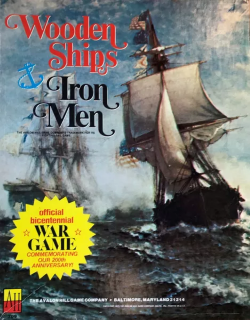
Wooden Ships and Iron Men is a naval board wargame simulating naval combat during the Age of Sail that was published by Battleline Publications in 1974, then revised and republished by Avalon Hill the following year.
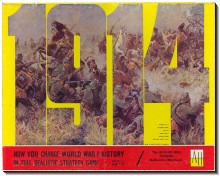
1914 is a board wargame published by Avalon Hill in 1968 that simulates the first few months of World War I on the Western Front.
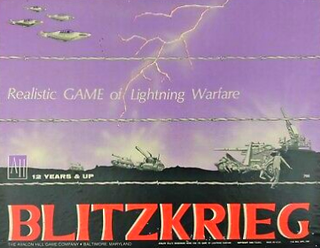
Blitzkrieg is a strategic-level wargame published by Avalon Hill in 1965 that simulates a non-historical attack by one major power against another using the blitzkrieg strategy. It was the first commercial wargame that did not simulate an actual historical battle, and with almost 400 counters, it was a precursor to the "monster" wargames of the 1970s featuring more than a thousand counters.

Jutland is a naval board wargame published by Avalon Hill in 1967 that simulates the Battle of Jutland in the North Sea during World War I. Upon its release, Jutland was commended for its gameplay and mechanics, but criticism surrounded the complex rules and playing time.

Battle of the Bulge is a board wargame published by Avalon Hill (AH) in 1965 that simulates the World War II battle of the same name. General Anthony McAuliffe (ret.), who had been commanding officer at Bastogne during the Battle of the Bulge, was a consultant during the game's development. The game proved popular and sold more than 120,000 copies, but was dogged by criticisms of historical inaccuracies, and was finally replaced by a completely new edition in 1981. A third edition in 1991 was released as part of the Smithsonian American History Series.
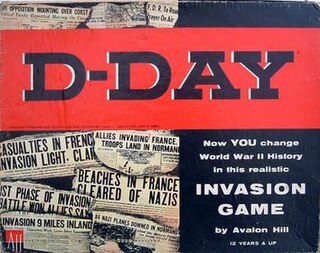
D-Day is a board wargame published by Avalon Hill in 1961 that simulates the six months of the European Campaign of World War II from the Normandy Invasion to the crossing of the Rhine. It was the first wargame to feature the now ubiquitous hex grid map and cardboard counters, and was revised and re-released in 1962, 1965, 1971, 1977 and 1991.

Afrika Korps is a board wargame published by Avalon Hill in 1964 and re-released in 1965 and 1978 that simulates the North Africa Campaign during World War II.

Air Assault on Crete is a wargame published by Avalon Hill in 1977 that simulates the Battle of Crete during World War II.
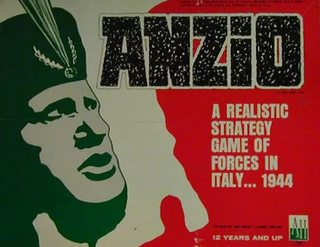
Anzio is a board wargame published by the Avalon Hill game company first in 1969 and again in 1971, 1974, and 1978. The title is misleading as the game is not an operational-level treatment of the Battle of Anzio but is in fact a strategic level game covering the entire Italian theater of operations in World War II from the autumn of 1943 to the end of the war in Europe.
Guidon Games produced board games and rulebooks for wargaming with miniatures, and in doing so influenced Tactical Studies Rules, the publisher of Dungeons & Dragons. The Guidon Games publishing imprint was the property of Lowrys Hobbies, a mail-order business owned by Don and Julie Lowry. About a dozen titles were released under the imprint from 1971 to 1973.
Don Lowry is a wargamer, businessman, illustrator, and game designer who is best known as the publisher of Chainmail and the editor of Panzerfaust Magazine.

Stalingrad is a strategic-level board wargame published by Avalon Hill in 1963 that simulates the first 24 months of the war between Germany and the Soviet Union during World War II. As one of the first board wargames it was extensively played and discussed during the early years of the wargaming hobby.
Panzer Campaigns is a series of operational level wargames originally developed by John Tiller Software, and currently by Wargame Design Studio. The games were originally published until 2010 by HPS Simulations, then self published by John Tiller Software until being bought out by Wargame Design Studio in 2021, after Tiller's death. There are currently 31 titles in the series, spanning the various fronts of World War II.

Battles for the Ardennes is a "quadrigame" — a board wargame that contains four different battles using one set of rules — originally published by Simulations Publications, Inc. (SPI) in 1978 that simulates Second World War battles in the Ardennes Forest region in 1940 and again in 1944.
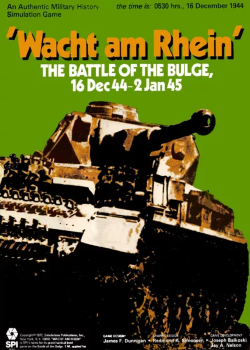
Wacht am Rhein is a grand tactical monster board wargame published by Simulations Publications, Inc. (SPI) in 1977 that simulates Germany's Battle of the Bulge offensive in late 1944 during World War II.

Ironbottom Sound, subtitled "The Guadalcanal Campaign", is a naval board wargame published by Quarterdeck Games in 1981 that simulates the Naval Battle of Guadalcanal during World War II. Four editions have been released by various publishers over forty years.
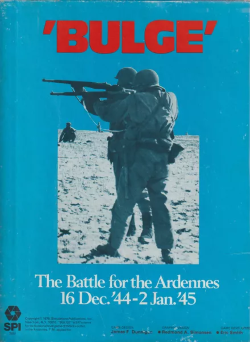
Bulge, subtitled "The Battle for the Ardennes, 16 Dec '44–2 Jan '45", and also published as The Big Red One: The Game of the First Infantry Division at the Battle of the Bulge, is a board wargame published by Simulations Publications Inc. (SPI) in 1980 that simulates the World War II German offensive in December 1944 known as the Battle of the Bulge.

Barbarossa: The Russo-German War 1941–45 is a board wargame published by Simulations Publications Inc. (SPI) in 1969 that simulates the conflict between Germany and the Soviet Union on the Eastern Front of World War II. This was only SPI's second game produced during a preliminary round of "Test Series" games, and proved to be the most popular. Despite the title, taken from the German operational name for their initial invasion of the Soviet Union, the game covers the entire Eastern Front campaign from the German invasion in 1941 to the Fall of Berlin in 1945.

1918, subtitled "Operation Michel: March 21–30, Germany's Last Chance in the West", is a board wargame published by Simulations Publications Inc. (SPI) in 1970 that simulates Operation Michael, the final German offensive on the Western Front in which they tried to win the war or at least force peace talks before American soldiers started to arrive on the Western Front in force. The game was well received by critics, but did not sell well.

Normandy: The Invasion of Europe 1944 is a board wargame published by Simulations Publications Inc. (SPI) in 1969 that simulates the D-Day landings on the beaches of Normandy, and the six days that followed as the German forces tried to prevent an Allied break-out. A second revised edition was published in 1971